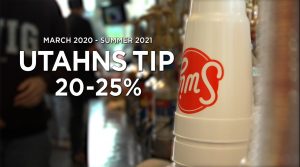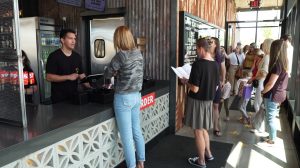SALT LAKE CITY, Utah — In the past few years, some Utahns may have noticed a change: cash tip jars replaced by tablets at fast-casual eateries. The options aren’t just a dollar or two, but buttons ranging from 15% to 35% on top of your bill.
Many of these now exist in places not known previously for soliciting tips, and the tip is given before the service has been rendered.
To tip? Or not to tip?
Whether they sell chicken, soda, brisket or cookies, step into a fast-casual restaurant and you’ve likely seen it: the counter, the eager employees, the tablet register.

Tablet tipping causes some anxiety for fast-casual dining customers. (Tanner Siegworth, KSL TV)
You stand in line, order your food, and once they ring up the bill, you have a choice and maybe some anxiety about the interaction.
“They’re standing there waiting for you,” said Jahni. “’Well, are you going to tip us?’”
“Do I have to tip because they’re looking at me?” questioned Carson.
“Why are you putting me under this pressure?” lamented Korbyn. “You feel like, anxiety almost.”
Everyone we spoke with had an opinion about tipping at restaurants without traditional servers.
“I feel it’s a little bit aggressive, to be honest,” said Sue Mika.
“I’m okay with tipping up front, because I know I’m going to get my food in general,” said Hayden.
“I’m just expecting to get that service, no matter what,” said Ally of the fast-casual dining experience. “You’re already getting paid to do your job, right?”
“I always, always tip,” said Jazmin.
Incentivizing restaurant work
To the folks running these restaurants, tipping may be saving their business.
“Restaurants are busier than they’ve ever been before and it is an employee market,” explained Jessica Moyer, Vice President of Learning and Development for Savory Management. “We have to fight for every single individual that chooses to work with one of our companies.”
The venture capital company owns several Utah fast casual dining establishments, like R&R BBQ and The Crack Shack.

Mike Headrick talks with Jessica Moyer of Savory Management. (Tanner Siegworth, KSL TV)
Moyer explained the restaurant industry has struggled severely with staff turnover. Tipping offers an incentive to attract and retain employees. “It’s a huge competitive advantage to be able to offer the tip option versus somebody who doesn’t,” she said.
Savory isn’t alone.
A look through the classifieds at fast-casual dining jobs found an average starting wage between $12 to $14.50 an hour. Nearly 75% of ads KSL Investigators reviewed promised shared tips, adding anywhere from $2.50 to $7 an hour to that base salary.
Additionally, we found fast-casual restaurants offering 401K, health and dental insurance, and tuition reimbursement to attract talent.
Despite paying sometimes more than double the minimum wage, fast-casual restaurants netted an average 20% in tips from Utahns between March 2020 and the summer of 2021, according to data from technology company Square.
During the height of the pandemic, in mid-April 2020, the average tip rate reached nearly 25%.

Data from technology company Square says Utahns tip 20-25% on average at fast-casual restaurants. (Tanner Siegworth, KSL TV)
At fast-casual restaurants, we were told the tip money is usually pooled, or shared with all team members eligible to receive tips.
KSL Investigators discovered the laws around tipping are specific: those with titles of “chef,” “dishwasher,” “cook,” or “janitor” are not eligible for tip pooling.
But when we examined job postings for fast-casual restaurants, we found many companies no longer give out specific titles, adopting “team member” as an overall job description with many roles, including food preparation. This may allow for more robust tip pooling.
We asked Moyer if she believed soliciting tips instead of raising meal prices was a way to pass on business costs to the customer.
“I don’t think that’s the case,” she responded. “Every single penny that is given as a tip is redistributed directly to the employee. It doesn’t actually lower our cost; it just helps us retain people.”
Toast, a restaurant point-of-sale equipment company, said in press release that utilizing tablet ordering and payment resulted in “doubled” tips for one restaurant. The manager enthused, “There are dishwashers that are now making $35 an hour. My employee retention is now through the roof.”
The psychology of tipping
Tipping used to be reserved for sit-down dining at a restaurant, where workers’ take-home pay is based largely on the tips they receive.
Utah is one of 16 states that offer the Federal rate of $2.13 per hour minimum cash wage for traditional tipped employees. The highest tipped cash wage is California, at $15 per hour in restaurants with 26 or more employees.

Fast-casual diners order their meals at the counter. (Tanner Siegworth, KSL TV)
“Tipping was always kind of based on the quality of service that you got,” explained Ann House, director of the Financial Wellness Center at the University of Utah. “That would make workers try a little bit harder because a tip depended on it.”
House said the pandemic expedited a change in how Americans view tipping.
“We’re reexamining where we are and what tipping means. Is it based on service anymore? Is it based on this is just the cost now of going to a food truck? This is just the cost now of going to get some frozen yogurt?”
House explained tipping is a logical and emotional situation, and which side dominates a person’s “money personality” usually dictates if they tip and how much they tip.
Also coming into play, House said, are outside forces of marketing and technology.
“We as consumers absolutely can be driven, coerced,” said House. “It’s the music that’s being played in a restaurant. It’s how everything looks. It’s how the servers are dressed. All of this plays into what we as consumers are more likely to do or less likely to do.”
Something consumers are now less likely to do is carry cash. House explained the restaurant industry has seized this opportunity to maximize tips.
“There are studies that are decades old about how much more money we spend if it’s on a credit card than if we use cash,” said House. “So, when the tip is already there and you can just check 20%, that gives us one less thing to think about.”
House said of students she polled about fast-casual tipping, most were not fans of the anxiety that comes with tipping before they get their food.

Data from technology company Square says Utahns tip 20-25% on average at fast-casual restaurants. (Tanner Siegworth, KSL TV)
“The students that I talked to about tipping don’t like being pushed into it,” House explained. “They’re also very hesitant to hit the button when they’re being watched. They don’t like being manipulated, and that is, in a way, what’s going on.”
Pre-tipping becoming a cultural norm
Like it or not, the tipping paradigm appears to be shifting. Many diners we spoke with were fine to tip a few extra bucks, citing better pay for workers and keeping their favorite restaurants in business.
Most, as with House’s students, do not appreciate the social anxiety the situation brings with choosing a tip with staff watching. It’s something Moyer said they’re working to combat.

Technology has all but erradicated traditional tip jars. (Tanner Siegworth, KSL TV)
“The employee’s going to get really good at…just pretending that it isn’t happening, because that’s going to become part of their training,” she said.
Something that might ease anxiety? Moyer claimed employees don’t see how much you tip.
“It isn’t something they see directly on the register. They’re not like ‘Yes! I just got a tip,’” she said. “And they’re not treating you differently if you didn’t tip.”
Have you experienced something you think just isn’t right? The KSL Investigators want to help. Submit your tip at [email protected] or 385-707-6153 so we can get working for you.
